Norwood Scale: Stages, Causes and Treatments
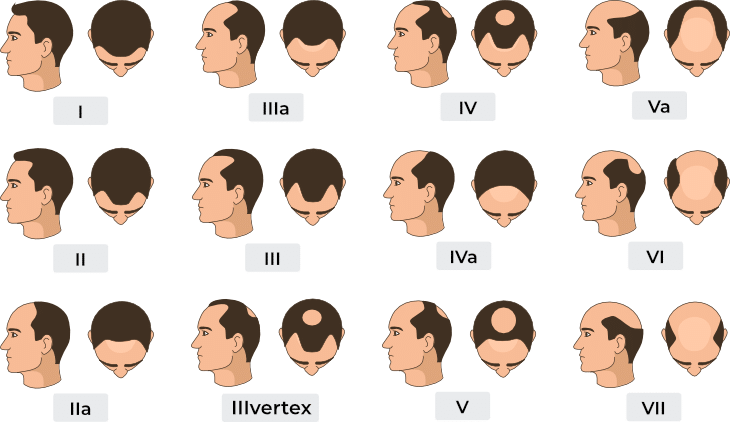
The Norwood Scale is a classification system used to measure the extent of male pattern baldness.
It ranges from Stage 1 to Stage 7, with Stage 1 indicating minimal or no hair loss and Stage 7 representing severe hair loss with only a narrow band of hair remaining.
The scale helps diagnose the progression of hair loss and determine appropriate treatment options.
Doctors can use simple pictures as a chart to accurately diagnose hair fall, inform patients about possible treatments, and evaluate how effective those treatments can be.
Table of contents
- What is the Norwood scale?
- How do experts diagnose male pattern baldness?
- At what Norwood stage should you seek treatment?
- Norwood Scale FAQ
What is the Norwood scale?
The Norwood balding scale measures the progression of pattern hair loss through the following 7 stages:
Stage 1
As Norwood 1 is the control stage, there are no visible signs of balding or a thinning hairline.
While hair loss may progress from this stage in the future, usually there is no treatment or hair transplant is recommended at this point.
Stage 2
On the Hamilton-Norwood scale, the 2nd stage of hair loss represents a mild recession at the hairline, specifically at the temples.
This is referred to as a mature hairline, and no further hair loss may occur at the crown (in some cases). While you may want to fill up the temples, doctors typically advise against hair implantation.
As you may continue to lose hair in the future, it might be difficult to connect the previously transplanted area with the rest of the hair.
However, medication may be recommended to slow or stop thinning.
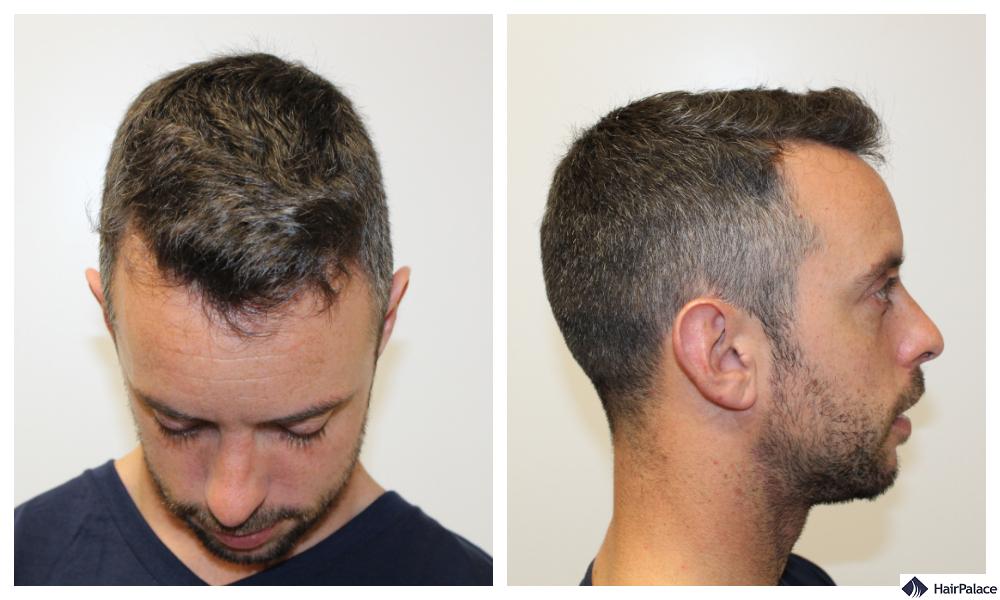
Average number of grafts required: 800-1000
Stage 3
Norwood 3 is the first stage where clinically significant hair loss appears.
A Norwood 3 hairline is typically characterised by a receding hairline at the left and right temple, creating one of three shapes — M, V, or U. Areas affected by recession will either be bald or show profound thinning.
While patients may continue to lose more hair over the years, it’s possible to reimplant the missing amount in a smaller procedure.
Doctors may also prescribe medication to slow down further thinning.
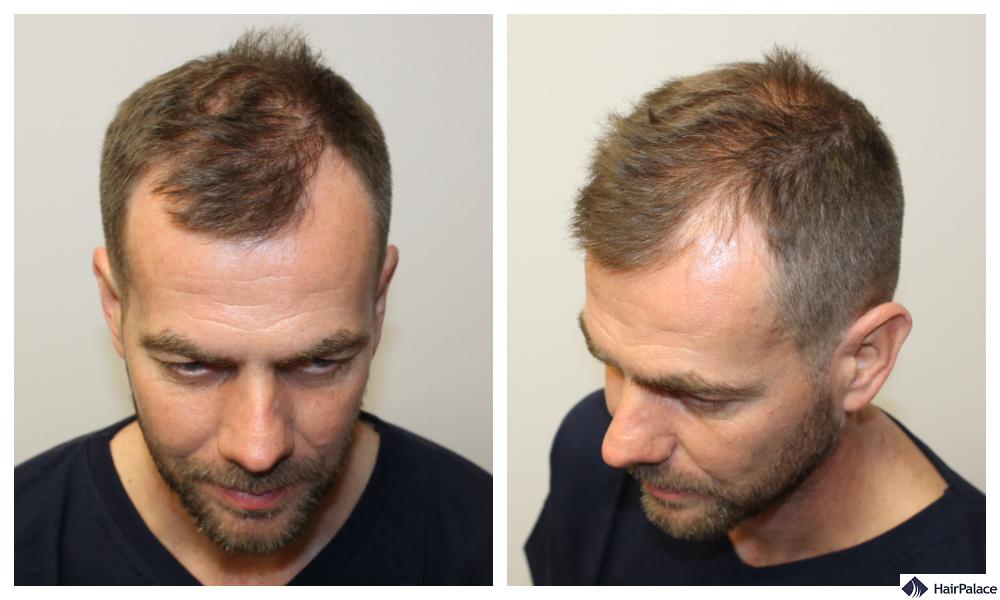
Average number of grafts required: 1000-1500
Stage 3 Vertex
Norwood 3 Vertex represents moderate hair loss with a bald spot on the crown, while the hairline remains at its stage 2 position.
Medication can help to slow down the progress of hair loss, while your suitability for hair transplantation would depend on your age and your expectations.
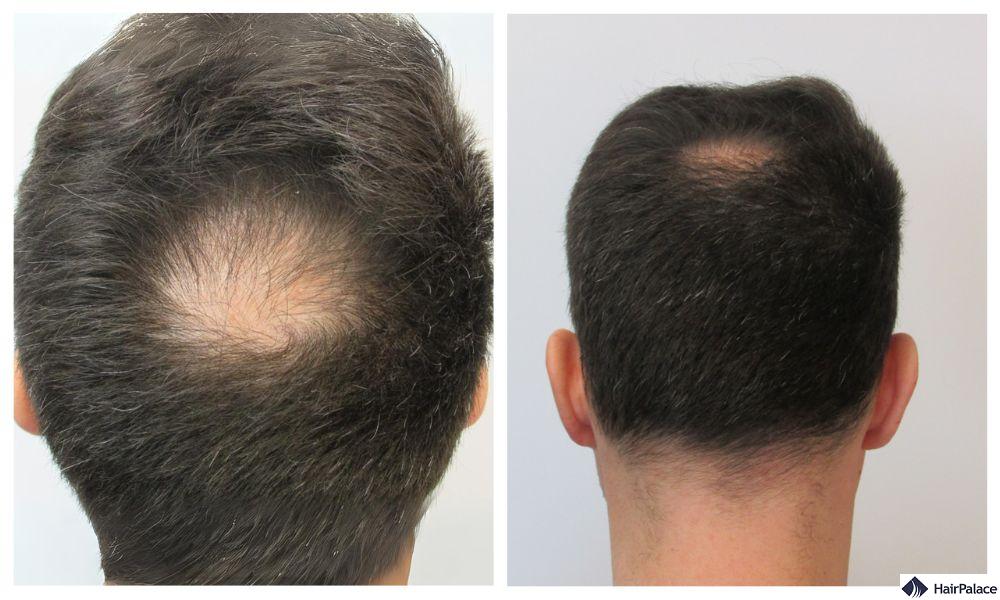
Average number of grafts required: 700-1500
Stage 4
Norwood 4 indicates further recession at the hairline, with little or no hair on top of the scalp. The patches of growth at the sides of the head are linked by a narrow band of hair.
Depending on the anticipated further thinning, the crown or the hairline can be restored with a hair transplant surgery, while the remaining areas of hair loss can be addressed in a separate session later on.
In the meantime, medication or alternative hair loss treatments may help you keep the rest of your hair.
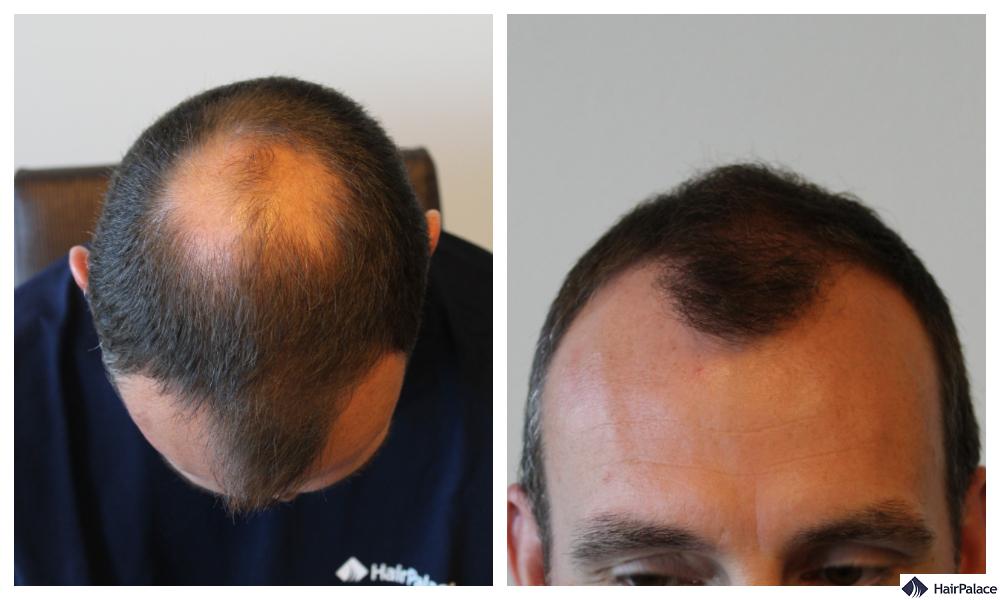
Average number of grafts required: 1500-2500
Stage 5
Stage 5 on the Norwood scale represents a more advanced male pattern hair loss. Both areas on either side of the band grow bigger, and the band of hair becomes thinner and starts to split in the middle.
Both areas on either side of the band grow bigger, and the band of hair becomes thinner and starts to split in the middle.
With a Norwood 5 hair transplant, implanting new hair follicles into the crown or the hairline is possible.
If the donor area allows, the other zone can be restored during a later session.
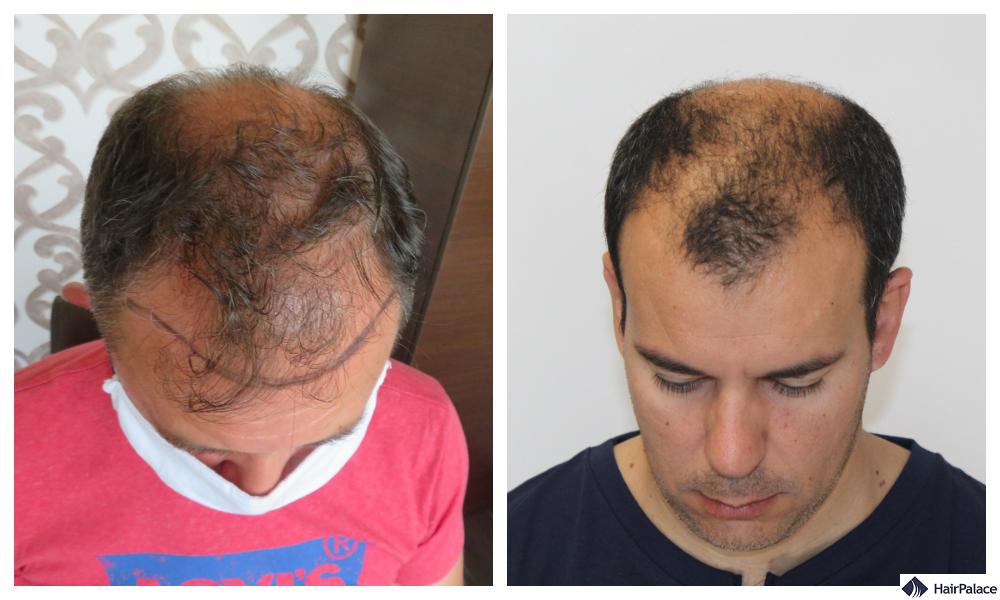
Average number of grafts required: 2000-2500
Stage 6
With Norwood 6, male pattern hair loss around the temples spreads to the bald vertex, and the band of hair on top of the scalp is at its thinnest or gone altogether.
At this stage of hair loss, medication is rarely proposed as a preventative measure. Hair transplant surgeons usually recommend the FUE method to revert the pattern of hair loss back to stage 4 or 5.
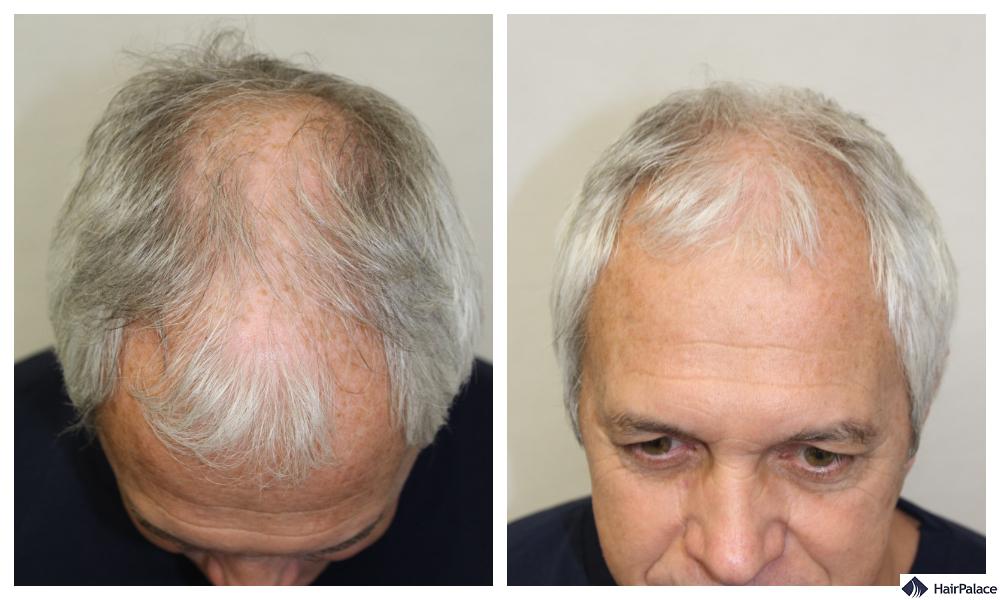
Average number of grafts required: 2500+
Stage 7
Patterned hair loss is at its most advanced at Norwood 7. You may have hair at the back and sides, but the top of the head is bald.
The amount of hair remaining around the sides and back will determine how much improvement can be achieved with transplantation. Stage 7 can be reverted to stage 6 or 5, but the proper design is key to a natural final look.
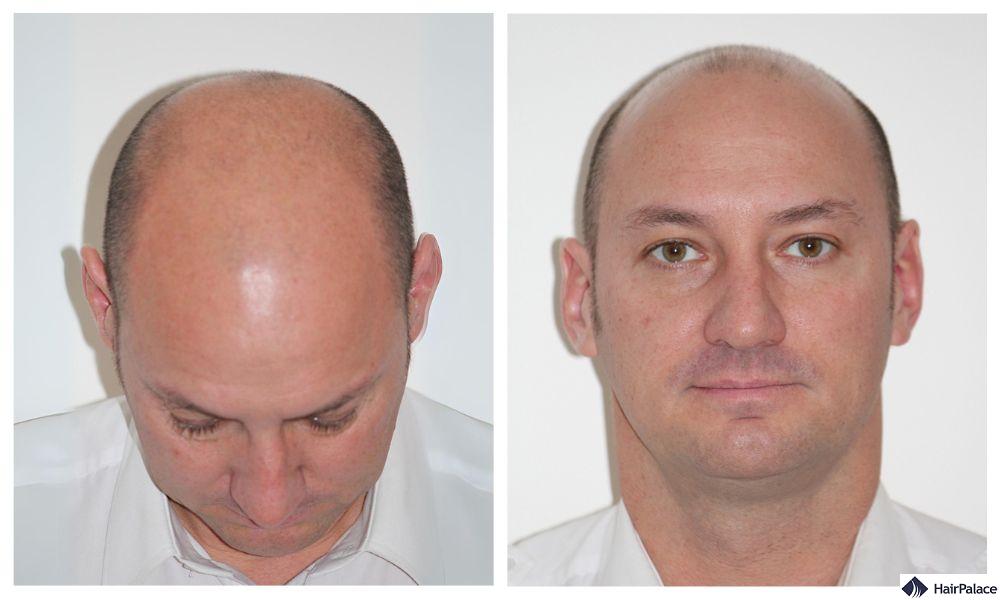
Average number of grafts required: 2500+
Class A
If you develop Norwood Class A baldness, your hairline recedes directly back across the scalp: there’s no island of hair in the centre or bald spot at the vertex.
How Does Hair Loss Look on the Norwood Scale?

How Do Experts Diagnose Male Pattern Baldness?
Specialists will perform a physical examination and discuss your medical history to diagnose your hair loss.
While the majority of hair loss affecting men is diagnosed as male pattern baldness, a doctor will aim to eliminate other possible causes if:
- You’re below the average age for this condition to appear
- Your hair loss is unusual for any reason
Dermatologists or specialists in hair loss will examine your scalp carefully during a consultation.
They’ll determine the pattern of the shedding, and the level of hair loss so far, and may pull multiple strands away to check your hair follicles.
They’ll likely use the Norwood balding scale to discuss their findings with you.
What Stage of The Norwood Hamilton Scale Should You Seek Treatment?
Everyone has a different tolerance level for the amount of hair loss they’re willing to take
If you’re bothered by your hair loss condition, you should seek advice from a professional regardless of the stage you’re at.
In most cases, it’s best to address the problem as early as possible, as this will give you the best chance to minimise or prevent more extensive baldness.
Get a free, no-obligation hair loss consultation at HairPalace and find out whether a hair transplant is the right solution for you.
Norwood Scale FAQ
The Hamilton-Norwood scale is a visual tool used to identify different degrees of male pattern baldness, numbered from 1 to 7. Doctors and hair restoration specialists often use the Hamilton-Norwood scale to assess baldness, though its reliability is questionable due to differing conclusions.
A mature male’s normal hairline starts between 2.4 and 3.2 inches above the eyebrows, and has a clear U-shape. Men may also have a natural widow’s peak, though that’s fairly uncommon.
Type I has minimal or no hairline recession. With Type II, recession occurs at the frontotemporal areas of the hairline, typically in symmetrical patterns. Type III is the minimal level of hair loss to be recognised as baldness on the Hamilton-Norwood scale.
A Norwood 2 hairline may be caused by a maturing hairline, but it could indicate that further hair loss and thinning will occur in the future. However, patients can take steps to prevent additional hair loss and reverse it, even lowering the hairline to its original position.
Hormones, genetics, and environmental factors can all lead to male pattern baldness. The genes you inherit from your mother and father affect how sensitive you are to androgens (a type of hormone), specifically DHT. DHT typically triggers miniaturisation and causes strands to become finer and shorter over time.
It’s impossible to prevent hair loss altogether. However, you can take steps to manage, and slow down the process. Prevention and treatment complement each other, but as men lose their hair at different ages, it’s down to the individual to choose when they should take action.
A specialist can measure the state of your male pattern hair loss with the Norwood hair scale, and determine what they can do to treat you. Transplantation will be the best option if you want lasting, natural hair growth.
Last medically reviewed on February 11th, 2025
- Norwood OT. Male pattern baldness: Classification and incidence. South Med J. 1975;68:1359–65https://pubmed.ncbi.nlm.nih.gov/1188424
- Olsen EA. Androgenetic alopecia. In: Olsen EA, editor. Disorders of Hair Growth: Diagnosis and Treatment. New York: McGraw-Hill; 1994. pp. 257–83https://scholar.google.com/scholar_lookup?title=Disorders+of+Hair+Growth:+Diagnosis+and+Treatment&author=EA+Olsen&publication_year=1994&
- Hong H, Ji JH, Lee Y, Kang H, Choi GS, Lee WS. Reliability of the pattern hair loss classifications: A comparison of the basic and specific and Norwood-Hamilton classifications. J Dermatol. 2013;40:102–6.https://pubmed.ncbi.nlm.nih.gov/23110308
- ISHRS. Effectiveness of 5% minoxidil in treating male pattern hair losshttps://ishrs.org/effectiveness-of-5-minoxidil-in-treating-male-pattern-hair-loss/
- Libecco JF, Bergfeld WF. Finasteride in the treatment of alopecia. Expert Opin Pharmacother. 2004 Apr;5(4):933-40. doi: 10.1517/14656566.5.4.933. PMID: 15102575.https://pubmed.ncbi.nlm.nih.gov/15102575/


